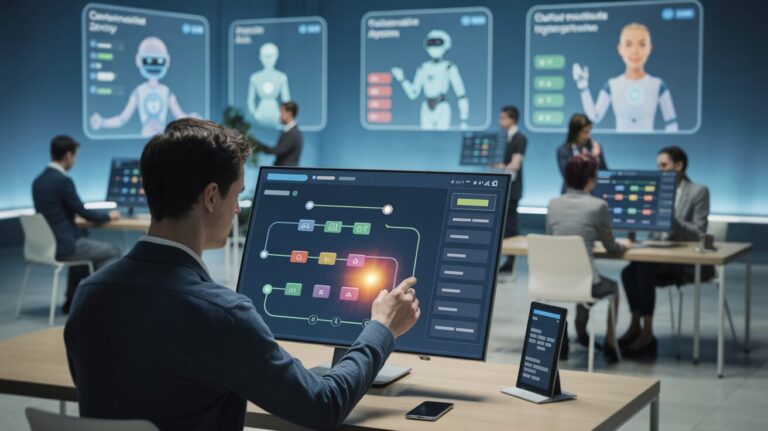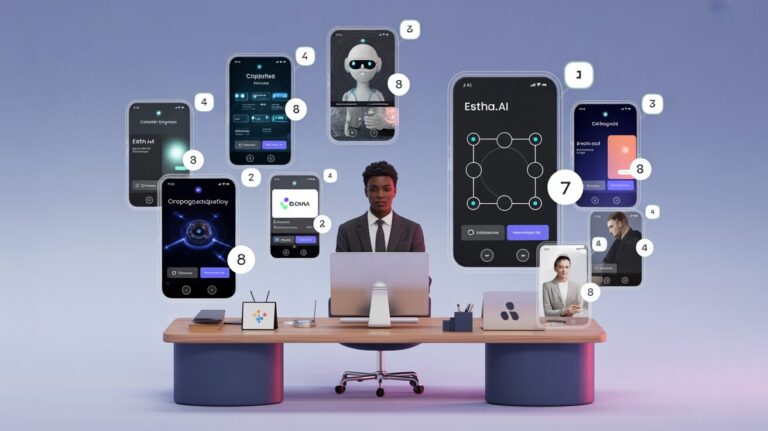Table Of Contents
- Introduction to AI Voice Apps
- How AI Voice Apps Work
- Types of AI Voice Apps
- Popular AI Voice Assistants
- Practical Applications of AI Voice Apps
- Creating Your Own AI Voice App
- The Future of AI Voice Technology
- Conclusion
What Are AI Voice Apps? A Complete Beginner’s Guide
Remember when talking to computers was just a sci-fi fantasy in movies like Star Trek or 2001: A Space Odyssey? Those futuristic visions have become our everyday reality with AI voice apps. From asking Siri about the weather to having Alexa turn on your living room lights, AI voice technology has seamlessly integrated into our daily lives.
But what exactly are AI voice apps? How do they work? And most importantly—how can you create one yourself without being a coding expert?
This comprehensive guide will walk you through everything you need to know about AI voice applications, from the basic technology behind them to practical ways you can build your own custom voice assistant, even if you’ve never written a line of code in your life.
AI Voice Apps: The Technology Behind Conversational AI
A beginner’s guide to understanding and creating AI voice applications
What Are AI Voice Apps?
AI voice apps (or voice assistants) are software programs that use artificial intelligence to understand human speech and respond appropriately. They combine speech recognition, natural language processing, and text-to-speech technologies to create natural interactions between humans and machines through voice.
Core Technologies
Speech Recognition
Converts spoken language into text using deep learning models trained on millions of hours of human speech.
Natural Language Processing
Interprets the meaning behind words, understanding intent, context, and entities mentioned in queries.
Text-to-Speech
Converts text responses into natural-sounding speech with appropriate intonation and emphasis.
Practical Applications
Smart Home
Control lights, thermostats, and other devices
Productivity
Set reminders, schedule appointments
Healthcare
Medication reminders, patient assistance
Education
Interactive quizzes, language learning
Retail
Voice shopping, personalized recommendations
Accessibility
Technology access for users with disabilities
Creating Your Own AI Voice App
Traditional Development
- Programming knowledge required
- Speech API integration
- Custom NLP implementation
- Months of development time
No-Code Platform Approach
- No programming knowledge needed
- Drag-drop-link interface
- Built in minutes instead of months
- Easily test and refine your voice app
The Future of AI Voice Technology
Multimodal interactions
Emotion recognition
Personalized voice profiles
Ambient computing
Enhanced privacy
Voice commerce
Ready to Create Your Own AI Voice App?
Build your custom AI voice application in minutes with Estha’s intuitive no-code platform. No technical expertise needed!
Introduction to AI Voice Apps
AI voice apps (also called voice assistants or voice applications) are software programs that use artificial intelligence to understand human speech and respond appropriately. They combine several technologies to create a seamless interaction between humans and machines through the most natural interface we have—our voice.
These applications have evolved dramatically over the past decade. What started as simple command-response systems with limited vocabularies have transformed into sophisticated assistants that can understand context, remember previous interactions, and even detect emotional tones in your voice.
The core purpose of AI voice apps is to make technology more accessible and intuitive. Instead of navigating complex menus or typing queries, users can simply speak naturally to accomplish tasks, find information, or control other devices.
How AI Voice Apps Work
Understanding the technology behind AI voice apps doesn’t require a computer science degree. At their core, these applications rely on three fundamental technologies working together:
Speech Recognition
Speech recognition (also called automatic speech recognition or ASR) is the technology that converts spoken language into text. This is the first critical step in the process—the computer needs to accurately capture what you’re saying before it can do anything with your request.
Modern speech recognition systems use deep learning models trained on millions of hours of human speech to accurately transcribe words even with different accents, background noise, or speaking styles. These systems have become remarkably accurate, with error rates approaching human-level performance in ideal conditions.
Natural Language Processing
Once your speech has been converted to text, Natural Language Processing (NLP) takes over. This is where the real intelligence happens. NLP helps the system understand not just the words you’ve spoken, but your actual intent.
For example, if you say, “What’s the weather like today?” the NLP component identifies this as a weather query for your current location and the current date. NLP can also handle more complex queries like “Will I need an umbrella for my trip to Seattle this weekend?” by recognizing entities (Seattle), timeframes (this weekend), and implied questions (precipitation forecast).
The most advanced NLP systems can maintain context across multiple exchanges, allowing for more natural conversations where you don’t need to repeat information.
Text-to-Speech
After the system has processed your request and formulated a response, Text-to-Speech (TTS) technology converts the text response back into spoken words. Modern TTS systems have become incredibly natural-sounding, with appropriate intonation, emphasis, and even emotional qualities.
The quality of TTS is crucial for user experience—robotic or unnatural-sounding voices can create a disconnected feeling, while natural-sounding voices build a sense of rapport and trust with the AI assistant.
Types of AI Voice Apps
AI voice applications come in various forms, each designed for specific use cases and environments:
General-purpose voice assistants: These are the familiar assistants like Siri, Alexa, and Google Assistant that can handle a wide range of queries and tasks from setting timers to answering trivia questions.
Domain-specific voice assistants: These focus on particular industries or functions, like healthcare assistants that help doctors record patient notes, financial assistants that provide stock updates, or educational assistants that help students with homework.
Voice-enabled devices: Smart speakers, smart TVs, and other IoT devices that incorporate voice interfaces as their primary control mechanism.
In-app voice features: Voice functionality embedded within larger applications, like voice search in a shopping app or voice dictation in a word processor.
Interactive voice response (IVR) systems: Advanced versions of the systems you encounter when calling customer service, capable of understanding natural language rather than just responding to numbered menu options.
Popular AI Voice Assistants
Several major voice assistants have become household names, each with its own strengths and ecosystem:
Amazon Alexa: Pioneer in the smart speaker category with the Echo devices, Alexa excels at smart home control and shopping integration. Its vast library of “skills” (third-party voice apps) makes it highly extensible.
Google Assistant: Leveraging Google’s search expertise, this assistant excels at answering questions and integrates deeply with Google services like Calendar, Maps, and Gmail.
Apple Siri: The first mainstream voice assistant on smartphones, Siri offers tight integration with Apple’s ecosystem and strong privacy features.
Microsoft Cortana: Originally designed as a personal assistant, Cortana has evolved to focus more on enterprise productivity and Microsoft 365 integration.
Samsung Bixby: Focused on controlling Samsung devices and appliances with an emphasis on device control rather than general knowledge.
Practical Applications of AI Voice Apps
The versatility of voice technology has led to its adoption across numerous sectors:
Home automation: Controlling lights, thermostats, security systems, and entertainment through voice commands has revolutionized smart home interaction.
Productivity: Voice apps can set reminders, schedule appointments, send messages, and create to-do lists without interrupting your workflow.
Healthcare: Voice assistants help patients remember medication schedules, assist doctors with documentation, and provide accessibility options for those with mobility limitations.
Education: Interactive voice quizzes, language learning applications, and accessible learning materials for students with different needs.
Retail: Voice shopping, inventory checks, and personalized recommendations enhance the shopping experience both online and in physical stores.
Customer service: Advanced voice bots can handle common customer inquiries, reducing wait times and freeing human agents for more complex issues.
Accessibility: Voice interfaces provide critical technology access for users with visual impairments, motor limitations, or learning differences.
Creating Your Own AI Voice App
There was a time when building voice applications required extensive programming knowledge, AI expertise, and significant resources. Today, the landscape has completely changed, with multiple approaches available depending on your technical background:
Traditional Development Approach
For those with programming experience, traditional development involves:
Speech API integration: Using services like Google’s Speech-to-Text, Amazon Transcribe, or Microsoft’s Speech Service.
NLP implementation: Either building custom NLP models or leveraging services like Dialogflow, Amazon Lex, or Wit.ai.
Voice assistant platform development: Creating skills for Alexa or actions for Google Assistant using their respective development kits.
This approach offers maximum flexibility but requires significant technical expertise and development time, often taking months to create and refine a voice application.
No-Code Platform Approach
The emergence of no-code platforms has democratized voice app development, allowing anyone to create sophisticated AI voice applications without writing code. This approach offers several advantages:
Accessibility: No programming knowledge required—if you can use a drag-and-drop interface, you can build a voice app.
Speed: What might take months with traditional development can be accomplished in minutes or hours.
Cost-effectiveness: Significantly lower development costs without the need for specialized developers.
Iteration: Easily test and refine your voice app based on user feedback.
Platforms like Estha have revolutionized this space by providing intuitive interfaces where you can create custom AI voice applications by simply dragging, dropping, and linking components. This approach allows professionals from any field—whether you’re a content creator, educator, healthcare provider, or small business owner—to create voice apps that leverage their unique expertise.
With Estha’s no-code platform, you can build a voice-enabled chatbot, expert advisor, or interactive quiz that reflects your brand voice in just 5-10 minutes, then embed it directly into your existing website or share it through other channels.
The Future of AI Voice Technology
Voice technology continues to evolve rapidly, with several emerging trends that will shape its future:
Multimodal interactions: Future voice assistants will combine voice with other inputs like gestures, facial expressions, and environmental awareness for more natural interactions.
Emotion recognition: Advanced systems will detect emotional states from voice patterns and adjust their responses accordingly, showing empathy when you’re stressed or matching your excitement when you’re celebrating.
Personalized voice profiles: Voice assistants will recognize different household members and provide personalized responses based on individual preferences and needs.
Ambient computing: Voice interfaces will become increasingly ambient—always available but only engaging when needed, blending seamlessly into our environments rather than being tied to specific devices.
Enhanced privacy: As voice technology becomes more pervasive, advances in on-device processing will allow more voice interactions to happen locally without sending data to the cloud, enhancing privacy.
Voice commerce: Voice shopping is expected to grow exponentially, with more sophisticated product recommendations and seamless payment processing.
Conclusion
AI voice apps have transformed from novelty features to essential tools that make technology more accessible, efficient, and human-centered. As we’ve explored in this guide, voice technology combines several sophisticated AI components—speech recognition, natural language processing, and text-to-speech—to create intuitive interfaces that understand and respond to our natural way of communicating.
The most exciting aspect of today’s voice app landscape is its accessibility. What once required teams of developers and AI specialists can now be created by anyone with domain expertise using no-code platforms. This democratization of AI voice technology opens up endless possibilities for innovation across every industry.
Whether you’re looking to enhance customer service, create accessible educational content, streamline healthcare processes, or simply add a new dimension to your personal brand, AI voice applications offer a powerful and increasingly accessible medium.
The future of human-computer interaction is conversational, and the tools to participate in this revolution are now available to everyone—no coding required.
Ready to create your own AI voice application?
Build your custom AI voice app in minutes with Estha’s intuitive no-code platform. No technical expertise needed!



